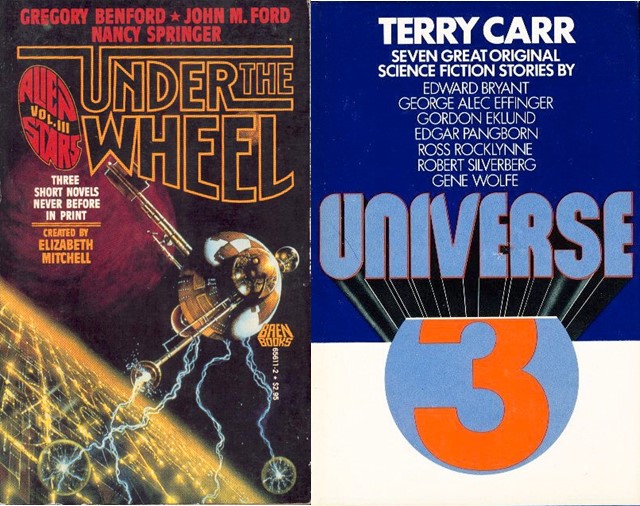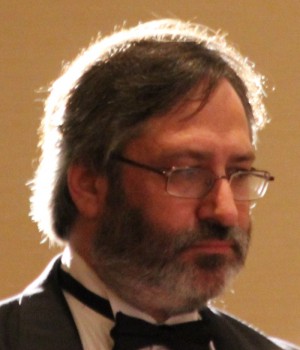Tor Doubles #25: Gene Wolfe’s The Death of Doctor Island and John M. Ford’s Fugue State

Cover for The Death of Doctor Island by Ron Walotsky
Tor Double #25 was originally published in September 1990 and collects Gene Wolfe’s The Death of Doctor Island and an expanded version of John M. Ford’s Fugue State. Both stories have settings which question the nature of reality, although in very different ways.
The Death of Doctor Island was originally published in Universe 3, edited by Terry Carr and published by Random House in October, 1973. It was nominated for the Hugo Award and the Nebula Award, winning the latter. It also won the Locus poll.
Wolfe’s story focuses on Nicholas de Vore, who rescues himself from a sandy pit to discover he is living on a nearly deserted island. He eventually learns that there are two other people living on the island, Ignacio, an older man who attacks Nick upon first meeting him, and Diana Phillips, a young woman who provides him with advice and assistance in surviving on the island. The most important “person” he meets, however, is the disembodied voice of “Doctor Island,” who is Nicky’s primary source of communication on the island.
As with many science fiction stories, the primary character is thrown into a situation and location which they don’t understand. This allows the author to introduce alien environments to the ready. In this case, the reader learns what is going on more quickly than Nicky does. The island he is exploring is a small space station (or perhaps portion of a space station) which is an annex to a mental institution. Nicky, Ignacio, and Diane are all patients and the voice of Doctor Island is a therapist, although it isn’t clear if he is an actual human or an artificial intelligence.
Through the novel, Nicky becomes aware of the psychological issues each of the characters have. The most obvious is that Ignacio has homicidal tendencies, demonstrated by his first encounter with Nicky. While Nicky avoids Ignacio for most of the story, he eventually, based on comments made by both Diana and Doctor Island, comes up with a method for handling Ignacio and avoiding his wrath.
Although Diane seems the most comfortable with the situation on the island, She has been sent there because she was dysfunctional in school and was impacting all those around her. Even as she helped guide Nicky, it is clear that her issues stem from her lack of self value. Diane serves as a lynchpin to both Ignacio and Nicky’s treatment, but at the same time, she is the most human of the characters in the story, becoming the only aspects for which the reader can feel sympathy.
The least obvious ailment is Nicky’s, perhaps because he is the viewpoint character and therefore the least able to understand what is going through his head. Eventually, however, Wolfe does reveal what he has been dealing with and what could have caused him to be sent to Doctor Island for treatment. Originally the newest inhabitant of the island, he has become the longest resident, ready to face his continuing treatment and possible future residents.
The setting on an uninhabited island may offer the sense of and Edenic presence in which the three can hear, however, as soon as Nicky comes into contact with Ignacio, the island takes on a more sinister aspect, raising comparisons with the island on which the plane crash landed in William Golding’s Lord of the Flies. While the marooned school boys there didn’t have the wisdom of an adult to fall back on, the role Doctor Island takes in Wolfe’s story, it isn’t clear how much influence Doctor Island actually has on Nicky, Diane, and Ignacio, with Nicky, especially, questioning Doctor Island’s authority.
One of the questions which the story never directly addresses is why the unnamed powers-that-be decided to group Nicky, Diana, and Ignacio together. Clearly there is the feeling that they can help each other come to terms with their various inflictions, although it isn’t clear exactly how that should work. Nevertheless, Wolfe shows that they are having a generally positive impact on each other. Another issue that is avoided it the inherent cruelty of the methodology of treatment for the three of them, especially given Nicky’s youth.
In 1971, Gene Wolfe was nominated for his first Nebula Award for the short story “The Island of Doctor Death and Other Stories.” He wound up losing to No Award. His friend, Joe Hensley, commented that he should write a story called “The Doctor of Death Island.” Wolfe took the idea, but wrote The Death of Doctor Island, which earned him his fourth Nebula nomination and his first award. He got around to publishing “The Doctor of Death Island” in 1978 and finished off the loose series with “Death of the Island Doctor” in 1983, which appeared in The Wolfe Archipelago, which collected the four stories.

Universe 3 cover by Bob Silverman
Fugue State was originally published in Under the Wheel, edited by Elizabeth Mitchell and published by Baen Books in January, 1987. This version has been expanded. The original story was nominated for the Nebula Award.
On its surface, Fugue State is a mystery story, focusing on an investigation by Forester and his partner, Danny Baker. They are on the trail of Glenn Margrave and come into contact with two women, Irene Kiel and Jane Caladon. However, as the title indicates, they are living in a world which is a fugue. As the story progresses, the characters find themselves “recast” into similar roles acting out a completely different story in a universe with a different background.
In the first version of the story, when Margrave is captured by Forrester and Baker, he is given the “Vogel Conversion.” Vogel, the scientist for whom the process is named, is mostly off stage, but throughout the story he will remain important in each version, sometimes more mysterious, other times more approachable. Forester is always an authority figure no matter the world in which they live. Despite the changes in the setting and technology, each character has a role to play, creating a repetition in the fugue through which they move.
The Commander, who is in a position of power, and often opposition, to Forrester, comments that he wants to upend the game, change the rules, perhaps showing more cognition that the characters are in an unnatural state of existence.
The characters are not traditional archetypes, but seeing them repeatedly in differing roles gives the feeling that they are archetypical models. With Irene Kiel appearing as a victim, Forester as a hero, Danny Baker as a sacrifice, and so forth. No matter the situation, they characters must fill the roles in which they are cast. The unseen hand of fate rules over them and there is little they can do to break out of it.
The Vogel Conversion in the first story is supposed to reset Margrave’s memory, and each of the subsequent fugue states reset the memories of the various characters, although there is an indication that some form of memory can bleed through both the Vogel Conversion or the fugue resets. This can be seen as a form of racial memories, remembering things from potential earlier lives or through a sort of hive-mind mentality. When unexpected memories do remain, they can cause the characters confusion, such as when Margrave seems to remember his identity despite the Vogel Conversion.
At the beginning of each fugue instance, the characters clearly know each other and are aware of them, but without any actual history to support that knowledge, allowing them to create new relationships, which always fall into the same patterns. As each fugue plays out, the patterns become stronger and more familiar to the reader, even as the details differ. At the end, death or unconsciousness brings about the next fugue state, as if the characters are striving to achieve something, without knowing what it is and their ultimate failure to find it starts the experiment over again.
The missing scientist Karl Lyman Vogel, who created the conversion machine and is repeatedly referred to appears to not only be a source of the fugue state, possibly the creator of all the characters, and ultimately a MacGuffin for the characters to seek, eventually does appear, offering hospitality, and an explanation, of sorts, to the recurring characters.
The Commander’s reference to playing a game and the final conversation with Vogel also gives Fugue State a metafictional feeling to it. The characters do not appear to be aware that they are in a novella written by John M. Ford, but they are aware, to varying degrees, that they may be in some sort of fictitious experiment instituted by Vogel to learn about the way memory works.
The nature of the fugue state as depicted in the novella, gives Fugue State a disjointed feeling. While that works well for some novels, the need to be reintroduced to characters who the reader feels they already know heighten that sense of distance. Ford is adept at hiding clues in the story, but doesn’t provide the connections until near the end, rewarding tenacious readers, but also at a point after which other readers may have given up on the non-traditional narrative.
The cover for Fugue State was painted by Wayne Barlowe. The cover for The Death of Doctor Island was painted by Ron Walotsky.
 Steven H Silver is a twenty-one-time Hugo Award nominee and was the publisher of the Hugo-nominated fanzine Argentus as well as the editor and publisher of ISFiC Press for eight years. He has also edited books for DAW, NESFA Press, and ZNB. His most recent anthology is Alternate Peace and his novel After Hastings was published in 2020. Steven has chaired the first Midwest Construction, Windycon three times, and the SFWA Nebula Conference numerous times. He was programming chair for Chicon 2000 and Vice Chair of Chicon 7.
Steven H Silver is a twenty-one-time Hugo Award nominee and was the publisher of the Hugo-nominated fanzine Argentus as well as the editor and publisher of ISFiC Press for eight years. He has also edited books for DAW, NESFA Press, and ZNB. His most recent anthology is Alternate Peace and his novel After Hastings was published in 2020. Steven has chaired the first Midwest Construction, Windycon three times, and the SFWA Nebula Conference numerous times. He was programming chair for Chicon 2000 and Vice Chair of Chicon 7.